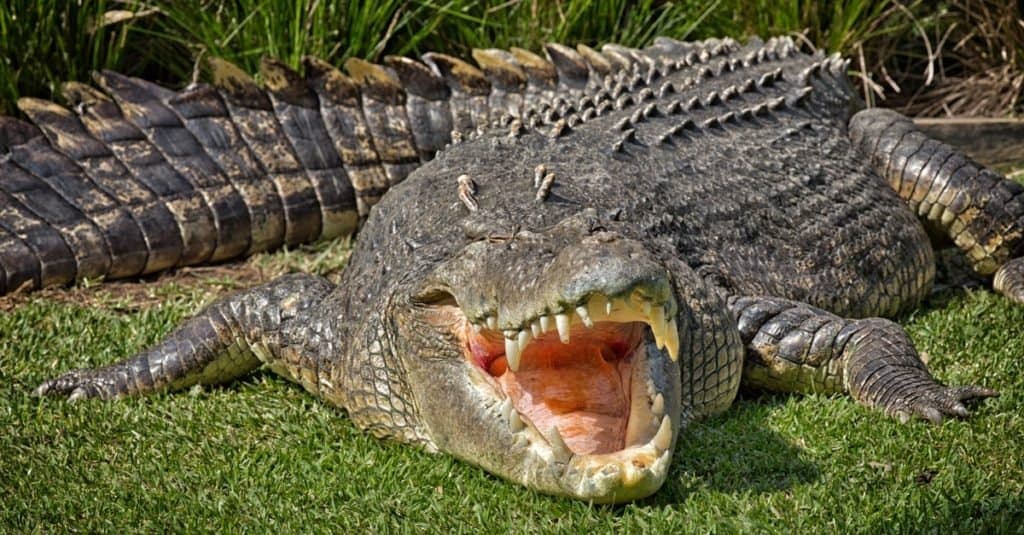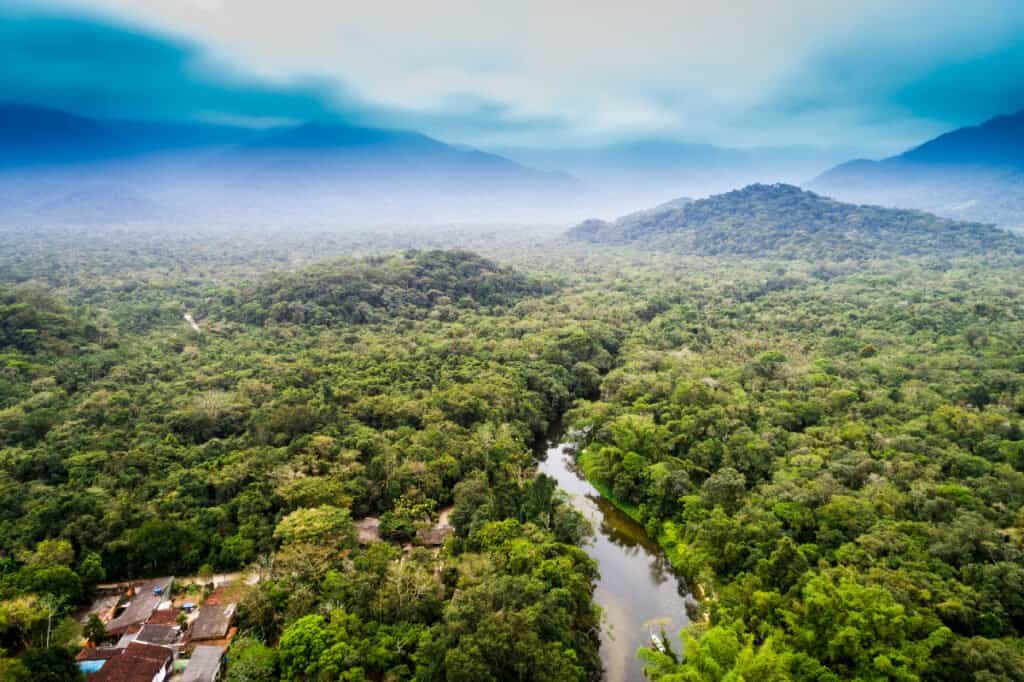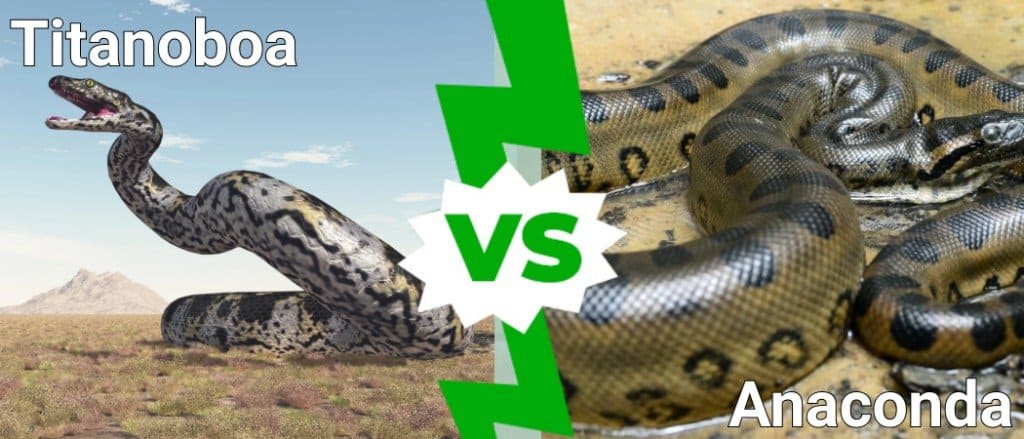When most people think of massive snakes, the first one that comes to mind is the anaconda. Anacondas might be the largest snake these days, but they weren’t always the biggest. In fact, anacondas are positively small compared to one monster snake called the Titanoboa.
Take a look at what was probably the largest snake to ever slither across the earth and learn why we should be thankful these reptiles are extinct these days!
How Large is the Titanoboa?

A Titanoboa was about 8 times longer than humans are tall!
©Michael Rosskothen/Shutterstock.com
The Titanoboa was incredibly massive, reaching lengths of about 40-50ft and weighing over 2,500 lbs. That snake makes every other snake that we have on the planet today seem small by comparison. For reference, 40-50 feet is roughly the height of a four-story building. Yikes.
According to unconfirmed reports, the largest anaconda that was ever found measured 33ft long and weighed about 880 lbs. Supposedly, this monstrous anaconda’s head was three feet across, and one can only imagine the size of prey this creature could hunt and eat. However, the largest reliably confirmed anaconda size is 215 pounds and just over 17 feet long.
The Titanoboa is so much longer and thicker than the anaconda, making it a much more dangerous creature. Although we have fossil records of this animal, many questions exist such as this creature’s preferred environment, whether it could lift a section of its body off the ground to strike, and what it ate.
While we can speculate on some of these questions, we can all agree that a Titanoboa would be far more frightening if it was able to raise even 1/5 of its body off the ground.
Fun Facts: Titanoboa
Titanoboa is a fascinating ancient creature that lived approximately 60 million years ago during the Paleocene epoch. This species of snake was one of the largest ever known, growing up to an impressive 13 meters (43 feet) in length.
Discovered in the Cerrejón coal mine in Colombia, Titanoboa has provided important information about the paleoclimate and the evolution of snakes. As an apex predator, it is believed to have fed on large reptiles, including prehistoric crocodiles.
In this section, we will explore 10 fascinating facts about Titanoboa, from its size and behavior to its significance in the fossil record:
- Titanoboa is an extinct species of snake that lived approximately 60 million years ago during the Paleocene epoch.
- It was one of the largest snakes ever known, growing up to 13 meters (43 feet) in length.
- Titanoboa was discovered in Colombia in the Cerrejón coal mine.
- It is believed to have been an apex predator, feeding on large reptiles, including prehistoric crocodiles.
- Titanoboa is a part of the booid group of snakes, which includes boas and pythons.
- It lived in a warm, tropical environment with a temperature that was much higher than today.
- Fossils of Titanoboa have provided important information about the paleoclimate and the evolution of snakes.
- The size and body shape of Titanoboa suggest that it was an ambush predator, lying in wait for its prey.
- The discovery of Titanoboa has helped to fill the gap in the fossil record of snakes, providing insight into their evolution and diversity.
- The name “Titanoboa” means “titanic boa,” referring to its large size and the fact that it was a member of the boa family.
How Long Ago Did This Monster Snake Live?

The Titanoboa rose to prominence after most dinosaurs were wiped out.
©metha1819/Shutterstock.com
The Titanoboa lived between 58 million and 60 million years ago. We know this by the fossil record that indicates that this creature lived in that time. What is interesting about this period when the Titanoboa lived is that it is considered the Middle to Late Paleocene epoch.
This epoch is defined by its proximity to the Cretaceous-Paleogene extinction, the mass extinction that led to the deaths of most of the animal species on Earth at that time. Among those animals were the last massive terrestrial dinosaurs.
The end of those species combined with the unique conditions on Earth after the extinction event allowed for some creatures to grow to massive proportions. Among them was Titanoboa, which may have been one of the biggest, deadliest reptiles left around that time.
While the Titanoboa was certainly not a dinosaur, it’s worth wondering what would have happened if a dinosaur was walking through some tall brush and a Titanoboa grabbed it.
After all, those snakes were massive boas that probably killed their prey by wrapping it up and crushing or choking it to death. Depending on the dinosaur, they may have bitten off more than they can chew, though.
What Did Titanoboa Eat?

Although crocodiles are deadly, they were the prey of Titanoboa.
©PomInOz/Shutterstock.com
The monster snake Titanoboa most likely ate fish. With a creature so large, its energy needs must have been just as huge. That means Titanoboa was probably eating quite often or waiting to catch particularly large creatures.
Researchers believe that this snake was most likely the apex predator in its territory. With its massive size, large teeth, and ability to wrap up and crush whatever got too close to it, the Titanoboa didn’t need to worry about most predators.
Interestingly enough, the snake was found near the fossilized remains of large turtles and crocodiles. So, the chances are high that it had eaten those animals at some point too. Feasting on a crocodile is no small feat, of course. That shows the toughness and hunting abilities of this monster snake.
Unfortunately, we don’t know enough about the snake’s body to definitively state how it hunted. Since it’s like other boas, it’s assumed that this snake was a constrictor.
We can’t tell if the creature was abnormally fast, ambushed prey, or where they spent most of their time. Yet, we may surmise that they probably ambushed their prey and did not move over 10 mph. That seems rather obvious if we’re comparing them to snakes that exist today, like the anaconda or other boas.
Where Did the Titanoboa Live?

Titanoboa lived in the rainforests of Colombia.
©iStock.com/gustavofrazao
The remains of the monster snake called Titanoboa were found in a mine shaft in Colombia. According to the news report about the discovery, which took place in 2009, 28 fossils were found in Cerrejon. This is an area in the northern section of Colombia. These remains were the largest ever found up to that point and ever since.
It’s believed that the reason the Titanoboa was able to grow so large was due to the warmer climate in place around 60 million years ago. The increased temperatures allowed these cold-blooded creatures to grow much larger than most modern snakes.
How Does Titanoboa Measure Up to Other Modern Snakes?

While we’re on the topic of how this monster snake measures up to others, it’s worth comparing the Titanoboa to other modern snakes. Specifically, we are going to compare the Titanoboa to the anaconda as well as the reticulated python. These are two of the largest snakes that exist in the modern world.
The Titanoboa measured between 40 and 50 feet long and weighed about 2,500 lbs. The largest anaconda ever found, but not properly measured and recorded, measured 33 feet long and weighed 880 lbs.
Although that is quite a sizeable snake, the difference between a Titanoboa and this anaconda is like night and day. The Titanoboa had to be much thicker and more muscular in addition to much longer than an anaconda.
Another very large snake that exists in the present is the reticulated python. These snakes can grow longer than anacondas on average, but they are much thinner. The biggest python was 26.25 feet long (8 meters) and weighed about 550 lbs (250kg). This snake is about half as long as the largest Titanoboa and less than a quarter of its weight!
All in all, no snakes that exist today are as large as the Titanoboa, and we should be thankful for that fact. Even though the snakes were not terribly widespread, it’s not hard to imagine the threat they could pose to humans and livestock.
To some extent, we can only guess what these snakes looked like and how they behaved. If even half of the predictions are correct, though, these creatures were simply horrifying!
The photo featured at the top of this post is ©
Discover the 10 Most Beautiful Snakes in the World
Every day A-Z Animals sends out some of the most incredible facts in the world from our free newsletter. Want to discover the 10 most beautiful snakes in the world, a "snake island" where you're never more than 3 feet from danger, or a "monster" snake 5X larger than an anaconda? Then sign up right now and you'll start receiving our daily newsletter absolutely free.
Thank you for reading! Have some feedback for us? Contact the AZ Animals editorial team.







